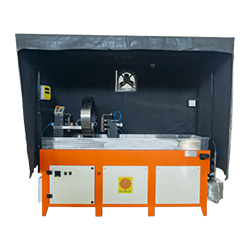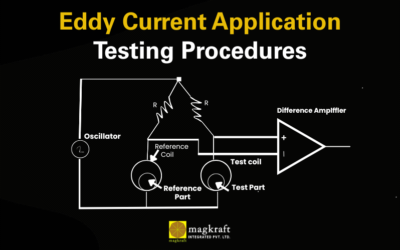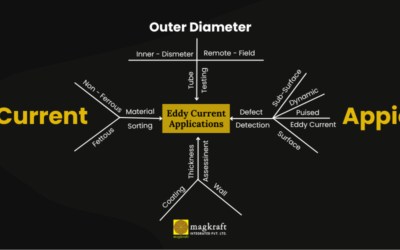Homepage > Coil Springs
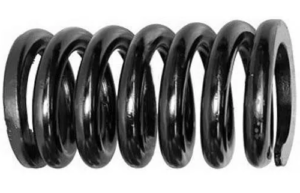
The geometry of a coil spring is unique and demands a special method of magnetization.
The Coil spring needs to be magnetized in two directions perpendicular to each other for detection of defects in all directions. One magnetic field is generated by passing a current through the length of the Coil spring.
Calculation of head shot current is done as per the formula given in ASTM standards.
Head Shot Current = 20 X Diameter(mm)
In the above formula, the diameter should be taken as diameter of the rod from which the spring is made and not the outer diameter of the spring.
With this type of excitation, transverse defects in the spring can be detected.
The 2ndmagnetic field is generated by using a central conductor.
Calculation of current for this shot is done as per the formula given in ASTM standards.
Head Shot Current = 20 X Diameter (mm)
In the above formula, the diameter should be taken as the outer diameter of the spring.
Flaws in the longitudinal direction, that is parallel to the axis of the spring can be detected using this magnetization.
A horizontal bench type machine is used to perform magnetic particle testing on Coil springs. Coil spring is placed on the steady rollers placed on the machine. A pneumatically operated arrangement is used to clamp the Coil spring from both ends. Pneumatic clamping ensures that there is no sparking when high current is passed through the Coil spring. Use of braided copper pads is also recommended to eliminate arcing sparks.
A copper conductor connected to a pneumatic cylinder is used for central conductor magnetization.
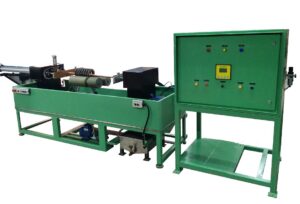
Testing Procedure for conventional machines
- Clean up & dry the Coil spring’s surface before inspecting.
- The Coil springis placed on the steady rollers.
- Now apply magnetic solution bath to the Coil spring.
- Press the ‘Cycle Start’ button.
- The Coil spring automatically gets clamped.
- Stop the flow of bath.
- Now, the current passes through the Coil spring.
- It shows up on the digital metering unit.
- The Coil spring automatically gets de-clamped.
- Inspect the Coil spring under UV light for transverse defects. Rotate on steady rollers.
- Press the ‘Cycle Start’ button.
- Now, again apply bath to the job.
- The central conductor comes out, passes through the spring & connects to the tail stock.
- Stop the flow of bath.
- Now the current passes through the copper rod.
- It shows up on the digital metering unit.
- Inspect the Coil spring under UV light for longitudinal defects. Rotate on Rollers
- Demagnetize
suitable products
Standard MPI Machines
Engineered for precision and efficiency, the Standard Bench Type Magnetic Particle Testing Machine is suitable for entry level testing.
PLC Controlled MPI Bench
With PLC Controlled bench type Magnetic Particle Inspection Machine, you can accurately control the process parameters for reilable results.
Multidirectional MPI Bench
The ultimate solution for robust non-destructive testing, this machine offers multi-directional magnetization for inspection in all directions in one shot..
Demagnetizers
Demagnetizers stand as a key tool in maintaining excellence in production, with the flexibility to handle different materials and magnetism levels, coupled with energy-efficient and user-friendly design.
DIVE DEEPER: GET YOUR HANDS ON OUR PRODUCT BROCHURE!
Explore More, Discover Better!
- In-Depth Details
- Product Insights
- Expert Recommendations
Download Our Brochure Now!
Blogs
Coating Thickness Measurements by eddy current testing machine
Eddy Current Testing (ECT) is a non-destructive testing (NDT) method widely used to measure the thickness of non-conductive and conductive coatings over conductive substrates. This technique is especially useful for applications in aerospace, automotive, and...
Eddy Currents Application Testing Procedures
Eddy currents are electrical currents induced in a conductor by a time-varyingmagnetic field. Eddy currents flow in a circular pattern, but their paths are oriented perpendicular to the direction of the magnetic field. The Eddy current inspection method is a highly...
Magnaflux MPI Machine
PlC-Controlled MPI: Revolutionizing Non-Destructive Testing Magnaflux Magnetic Particle Inspection (MPI) is a key part of non-destructive testing (NDT). It helps find flaws on or near the surface of materials that react to magnets. PLC-controlled systems in Magnaflux...


